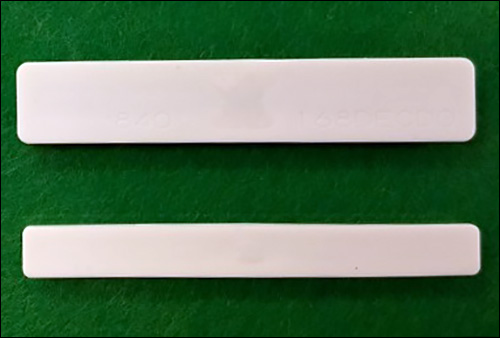Fujitsu Frontech North America (FFNA) has released what it calls one of the smallest laundry tags on the market with built-in RFID technology. The size is strategic—at 6 to 7 millimeters (0.23 to 0.28 inch) in width, it is sized to fit into the standard seam sewn in linens by manufacturers of such products as bed sheets, table cloths, uniforms and scrubs. The company announced the 5th General Super Slim Washable RFID Linen Tag at this month’s RFID Journal LIVE! conference and exhibition, held in Orlando, Fla.
The use of RFID by the health-care and hospitality markets has grown fast enough that it is putting pressure on manufacturers to insert RFID tags into their products before shipping them to customers—either the end users of the linens, uniforms, workwear and garments, or companies that service hotels, hospitals and other facilities.
The shrinking of the linen tag results from the company’s antenna engineering, says Dan Dalton, Fujitsu’s senior director of marketing and new product development. The product is now being tested in sample form by several companies, though Dalton declines to name or describe those companies. He says it will be available in volume by the fourth quarter of this year. According to the company, it is 30 to 40 percent smaller than most existing tags.
Laundries and garment-rental companies that serve hospitals, industrial and the hospitality industries have been behind much of the growth in RFID technology deployment for managing linens and garments. Because the items are typically moved back and forth between several sites for cleaning, storage and use, and in high volumes, the management of those items is traditionally difficult and can lead to inaccuracies and loss of product.
With RFID tags on the linens, the company explains, laundry facilities can know when each item is received for cleaning, and can track them through the washing, drying and folding processes, as well as when they are shipped to specific customers. The hotel or hospital can also use the technology to manage which linens are received and when they are moved to the laundry.
The challenge has been in applying the washable tags to linens. Because RFID tags have tended to be fairly large, sewing them onto linens has required modifications to the manufacturing process. In some cases, Dalton explains, companies have had to sew a pouch onto their products to hold the tag, or customize a larger seam to accommodate it.
However, those customers had indicated to Fujitsu that they hoped for a tag that would be small enough to be easily inserted into a typical 10-millimeter (0.4-inch) seam. The new slim tag accomplishes that, the company indicates—since it is between 6 and 7 millimeters wide, it can be inserted into the seam and sewn over, making it a less obtrusive addition to the manufacturing process. The tag can then remain invisible to users, and be protected from the rigors of washing and drying within the seam.
The Super Slim tag, Dalton says—like its predecessor, the WT-A533 Linen tag—can be read in batches of hundreds or thousands while moving through a portal or past a reader, at a distance of about 2 to 3 meters (6.6 to 10 feet). The tags are designed to be water- and heat-resistant, as well as able to sustain chemicals such as those used during cleaning.
The development of a tag that is less disruptive for the manufacturing of linens and related products is expected to make RFID technology deployments easier and more affordable, the company reports, since manufacturers will be more likely to apply the tags to all of their products.


